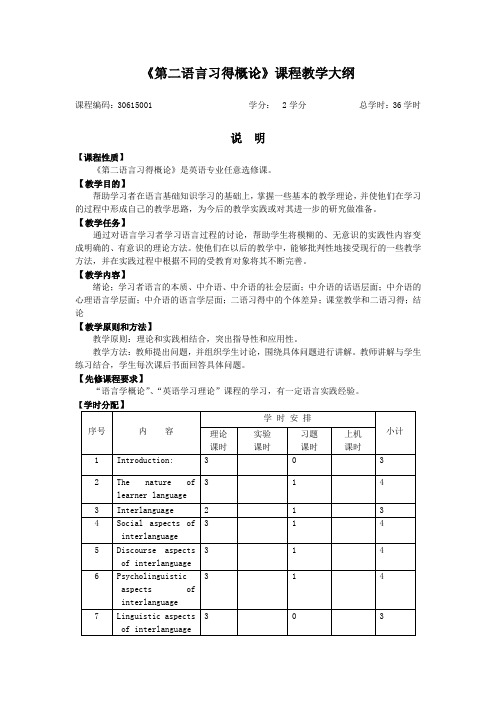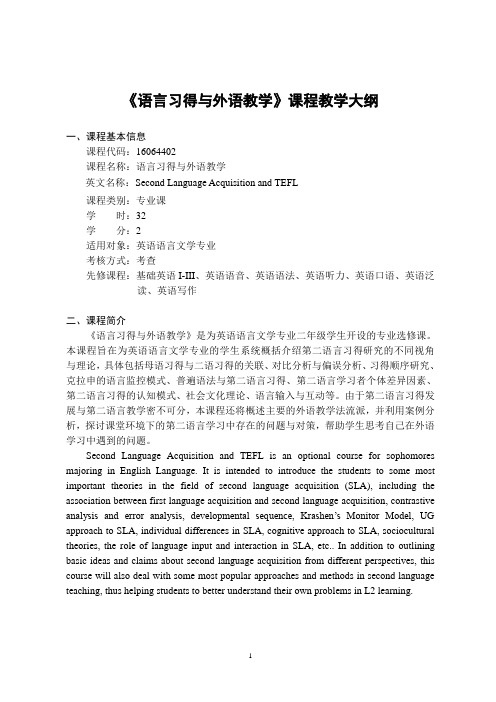二语习得教学大纲
《第二语言习得理论》课程教学大纲

《第二语言习得理论》课程教学大纲二、课程简介本课程是对外汉语专业的专业基础课。
本课程的主要教学内容为第二语言习得理论和主要研究内容,分析阐述了第二语言习得和相关学科,特别是语言学、第一语言习得等学科的关系,并按照时间顺序,分专题介绍先后在第二语言习得领域占据主导地位的核心理论,分别是“对比分析与偏误分析”“中介语研究”“第二语言习得顺序研究”“克拉申的语言监控模式”“第二语言学习者的语言系统变异研究”“第二语言习得研究的社会文化模式”“语言输入与互动研究”“普遍语法与第二语言习得”“多元发展模式”“第二语言习得的认知模式”。
三、课程教学总体目标培养学生从事对外汉语教学和研究的能力,让学生了解对外汉语教学理论和教学法的流派;了解并掌握对外汉语教学的过程、方法和技能;使学生具备对外汉语教学的基本理论,为将来的对外汉语教学实践打下基础。
四、理论教学内容及要求本课程开设的目的就是帮助学生在语言基础知识学习的基础上,掌握一些基本的第二语言习得的理论知识。
通过本课程的学习,使学生能明确掌握关于语言学习的理论,并有意识的运用有关学习者行为理论的原则来控制、改善自己的外语学习,最终形成关于第二语言习得的独立见解。
通过本课程的学习,可以为学生打下扎实的第二语言习得理论基础,并为学生以后的教学实践打下深厚的理论基础。
第一章第二语言习得研究概述【教学目标】理解第二语言习得研究的基本概念和学科性质(1)了解第二语言习得研究的发端与发展的简要回顾(2)理解第二语言习得研究的学科性质(3)掌握第二语言习得研究概述【学时分配】4【授课方式】讲授、讨论【授课内容】第三节第二语言习得研究概述第四节第二语言习得研究的学科性质第五节第二语言习得研究的发端与发展的简要回顾【教学重点和难点】(1)重点第二语言习得研究的学科性质(2)难点第二语言习得研究的基本概念【授课方法与手段】(1)教学方法讲授式、讨论式、启发式(2)教学手段多媒体【课外学习指导的要求】1.课外阅读资料 Understanding Second Language Acquisition2.作业与思考题的要求为什么第二语言习得研究领域的学者把Corder 和 Selinder发表的文章作为第二语言习得研究的起点?第二章对比分析与偏误分析【教学目标】了解对比分析和偏误分析的基本原理和研究方法(1)了解对比分析和偏误分析的基本原理(2)理解对比分析走向没落和偏误分析兴起的原因(3)掌握对比分析和偏误分析的研究方法【学时分配】4【授课方式】讲授、讨论【授课内容】第四节对比分析第五节偏误分析【教学重点和难点】(1)重点汉对比分析和偏误分析的研究方法(2)难点对比分析和偏误分析的基本原理【授课方法与手段】(1)教学方法讲授式、讨论式、启发式(2)教学手段多媒体【课外学习指导的要求】1.课外阅读资料 Understanding Second Language Acquisition2.作业与思考题的要求偏误分析是如何产生的?第三章中介语研究【教学目标】理解中介语理论的基本假设和中介语语用研究(1)了解中介语理论产生的历史背景(2)理解早期的中介语理论研究(3)掌握早期中介语理论的基本假设及后续研究;中介语语用研究【学时分配】4【授课方式】讲授、讨论【授课内容】第五节中介语理论产生的历史背景第六节早期的中介语理论研究第七节早期中介语理论的基本假设及后续研究第八节中介语语用研究【教学重点和难点】(1)重点早期中介语理论的基本假设(2)难点中介语语用研究【授课方法与手段】(1)教学方法讲授式、讨论式、启发式(2)教学手段多媒体【课外学习指导的要求】1.课外阅读资料 Understanding Second Language Acquisition2.作业与思考题的要求如何理解中介语语用学的定义?第四章第二语言习得顺序研究【教学目标】理解第二语言习得顺序研究的基本结论(1)了解第二语言习得顺序研究的缘起;(2)理解第二语言习得顺序研究的理论争议;(3)掌握第二语言习得顺序研究及其基本结论。
《二语习得》课程教学大纲

《二语习得》课程教学大纲一、教师或教学团队信息二、课程基本信息课程名称(中文):二语习得课程名称(英文):Second Language Acquisition课程类别:□通识必修课□通识选修课□专业必修课 专业方向课□专业拓展课□实践性环节课程性质*:□学术知识性□方法技能性 研究探索性□实践体验性课程代码:周学时:2 总学时:32 学分:2先修课程:语言学授课对象:英语师范专业学生三、课程简介二语习得是关于描述和解释第二语言学习过程及学习者因素的课程。
该课程对于英语师范生了解英语学习的过程,从而更好地进行英语教学具有重要意义。
本课程主要包括如下主要内容:二语习得的关键问题、中介语、语料收集方法、语料分析方法、个体学习者差异与第二语言习得、输入、互动与第二语言习得、学习者策略、课堂教学在第二语言习得中的作用、第二语言习得理论等。
四、课程目标1)本课程旨在使学生熟悉第二语言学习的基本原则,熟悉主要的术语、概念和理论。
2)掌握语料收集和分析方法,并能简单分析第二语言学习的过程、学习者差异、心理及认知因素等方面。
3)作为未来教师,能够分析语言学习和教学中出现的相关问题。
4)课程将为学生的毕业论文提供一定的理论依据和研究思路;同时使师范生从学习层面领悟教学,为今后的英语教学做准备。
五、教学内容与进度安排*第一章第二语言习得课程概述1. 课时数:2节课2. 讲授内容或训练技能,重点、难点第二语言习得的概念、相关术语及定义;双语、多语现象和现状。
3. 学生学习任务掌握本章节的概念和术语、参与课堂讨论、完成课堂陈述。
4. 教学方法教学按照下列程序展开:学生陈述---教师讲授---讨论---完成习题。
讨论主要有师生互动、小组讨论;对学生的课堂陈述,依据准备和表述情况进行评分。
5. 课外学习要求研读课本第二章内容,准备课堂陈述,完成课后习题(pp6)。
第二章第二语言习得课程基础1. 课时数:2节课2. 讲授内容或训练技能,重点、难点讲授内容包含语言学习本质,语言习得逻辑问题;学习和理解第二语言习得的框架。
最新二语习得Second Language Acquisition教学提纲

Theoretical i of
how language is represented in the mind and whether there
is a difference between the way language is acquired and
75
Second Language Acquisition
1. The Grammar-Translation Method (structuralism) 2. The Audio-Lingual Method (听说法) (structuralism, behaviorism s-r) 3. Communicative Language Teaching (交际法语言教学) (cognitive science, linguistic competent, communicative competent) 4. Content-based, Task-based Approaches (学科性方法)
Second Language Acquisition
Implicit learning is coming to learn the underlying structure of a complex stimulus environment by a process which takes place naturally, simply and without conscious operations. Explicit learning is a more conscious operation where the individual makes and tests hypotheses.
《第二语言习得概论》课程教学大纲

《第二语言习得概论》课程教学大纲课程编码:30615001 学分: 2学分总学时:36学时说明【课程性质】《第二语言习得概论》是英语专业任意选修课。
【教学目的】帮助学习者在语言基础知识学习的基础上,掌握一些基本的教学理论,并使他们在学习的过程中形成自己的教学思路,为今后的教学实践或对其进一步的研究做准备。
【教学任务】通过对语言学习者学习语言过程的讨论,帮助学生将模糊的、无意识的实践性内容变成明确的、有意识的理论方法。
使他们在以后的教学中,能够批判性地接受现行的一些教学方法,并在实践过程中根据不同的受教育对象将其不断完善。
【教学内容】绪论;学习者语言的本质、中介语、中介语的社会层面;中介语的话语层面;中介语的心理语言学层面;中介语的语言学层面;二语习得中的个体差异;课堂教学和二语习得;结论【教学原则和方法】教学原则:理论和实践相结合,突出指导性和应用性。
教学方法:教师提出问题,并组织学生讨论,围绕具体问题进行讲解。
教师讲解与学生练习结合,学生每次课后书面回答具体问题。
【先修课程要求】“语言学概论”、“英语学习理论”课程的学习,有一定语言实践经验。
【教材与主要参考书】教材:Rod Ellis 《第二语言习得》上海外语教育出版社,2000年。
参考书:P. M. Lightbown and N. Spada 《语言学习机制》上海外语教育出版社, 20XX年。
Rod Ellis《第二语言习的研究》上海外语教育出版社, 1994年。
大纲内容第一部分Introduction: Describing and Explaining L2 Acquisition【教学目的和要求】教学目的:本章是全书的绪论,学习的目的是弄清第二语言习得的概念和目标。
教学要求:明确什么是学习者语言等相关概念,从而在整体上使学生对第二语言习得的基本理论有个概括性的了解。
【内容提要】Ⅰ.The definition of second language acquisitionⅡ.The goals of second language acquisitionⅢ.Two case studiesⅣ.Methodological issuesⅤ.Issues in the description of learner languageⅥ.Issues in the explanation of L2 acquisition【教学重点与难点问题】教学重点:the definition of second language acquisition教学难点:the goals of second language acquisition【复习参考题】1. In what respects is Wes a ‘good language learner’ and on what respects is he not one?2. What is your own definition of a ‘good language learner’?第二部分The Nature of Learner Language【教学目的和要求】教学目的:学生了解学习者语言的本质。
《二语习得》课程教学大纲

【二语习得】课程教学大纲【课程代码】08024053【课程类别】专业任选课【学分】2【总学时】34【讲授学时】34【实验学时】【先修课程】《英语教师职业技能》【适用专业】英语专业师范方向高年级学生【教学目的】通过本课程的学习,要求学生了解第二语言(外语)习得的性质、特点、内容、理论研究流派、研究热点、教学原则、教学内容与方法等。
本课程采用多元视角,对二语习得与教学进行多学科、全方位的介绍与探讨,以便学生能够全面了解二语习得与教学全过程的诸方面,学习和研究二语习得与教学理论,从而加深对二语教学这一认知活动的理性认识,为进一步深入研究二语习得与教学打下基础,提高科研能力,提高运用理论探讨和解决英语教学问题的能力,力争成为积极、自觉的思考者和有独立解决问题能力的学习者、研究者。
【内容提要】第一章【语言、语言学习和语言教学】[基本要求] 了解语言教学中几个最基本的议题,即语言、语言学习和语言教学。
[重点难点]使学生掌握语言学习和语言教学理论基础的全貌,并引导学生在此基础上,经过认真、审慎、理智、全面的思考,从中悟出自己的语言教学思路或理论。
[讲授学时] 2 学时第一节 [语言、学习与语言教学]语言学习与教学语言学与心理学的趋势第二节[语言教学理论与方法]应用语言学语言教学理论与方法第二章【第一语言习得】[基本要求]要求学生了解第一语言习得是认识第二语言学习原理的基础、掌握第一语言习得所涉及的主要议题、概念和主流理论观点.[重点难点] 使学生意识到虽然本章议题都尚无定论,但第一语言习得研究与第二语言习得研究关系密切相关,其导向和成果对第二语言习得研究颇具启示.[讲授学时] 2 学时第一节 [第一语言习得理论]行为主义内在论功能主义第二节 [第一语言习得中的主要问题]能力与行为理解与产出先天本质与后天培养普遍语法系统性与变化性语言与思维模仿实践输入语篇第三章【第一语言习得与第二语言习得对比】[基本要求] 要求学生了解第一语言习得与第二语言习得可做的三类对比及三类比较重涉及的6个议题(关键期假设;神经学的研究成果;精神运动协调方面的探讨;认知心理学的观点;情感因素的作用;语言发展的因素)[重点难点]对本章所论述的因素进行综合思考,就任何一类比较形成自己的认识。
二语习得教学大纲

⼆语习得教学⼤纲《第⼆语⾔习得》课程教学⼤纲⼀、说明(⼀)课程简介:本课程是为英语专业和对外汉语专业三年级学⽣开设的⼀门专业选修课。
主要向学⽣介绍语⾔学习规律、影响语⾔学习的内外部因素以及学习者的个性特征。
(⼆)编写依据:《⾼等学校英语专业英语教学⼤纲》提出要培养具有扎实的基本功、宽⼴的知识⾯、⼀定的相关专业知识、较强的能⼒和较⾼的素质、⾯向21世纪的复合型外语⼈才。
其中⼀定的专业知识指英语专业学⽣毕业后可能从事的某⼀专业的基础知识。
英语师范专业学⽣毕业后将投⾝语⾔教育事业,因此很有必要学习第⼆语⾔习得领域的知识,以提⾼⾃⾝的语⾔学习效果,为今后的语⾔教育⼯作打下良好的基础。
(三)⽬的任务:让学⽣更好地了解语⾔学习规律、影响语⾔学习的内外部因素以及⾃⼰的个性特征,从⽽获得更好的外语学习效果。
(四)课程类别:专业选修课⼆、教学安排与学时分配表三、教学内容与知识点第⼀章绪论知识点:1. Why study the course?2. Definitions of SLA and L2A.3. Goals of SLA.4. Objects of SLA.5. The development of SLA.6. Basic terminology.第⼆章母语习得知识点:1. Behaviorist learning theory2. The nativist approach3. The cognitive approach4. The functional approach5. L1A vs. FLL:A.Physiological aspectB.Cognitive aspectC.Affective aspectD.Sociocultural aspect6. Error Analysis:Its purposeMajor stepsContributions and weakness7. Developmental pattern in learner’s language:‘L1A=L2A’ hypothesis8. Variability of learner languagedefinition of interlanguage / characteristics of interlanguage / systematic variability/ free variation9. Pragmatic aspects of learner languageA.requestsB.apologiesC.refusals第四章影响⼆语习得的外部因素知识点:1. Social factors and L2A: (age, sex , social class, ethnic identity, social environment: natural environment classroom environment)2. Input and interaction and L2A: (caretaker talk , foreigner talk, interlanguage talk, input frequency and L2A , comprehensible input and L2A , learner output and acquisition)第五章影响⼆语习得的内部因素知识点:1. Cognitive view vs. mentalist view.2. Cognitive accounts of L2A: (A general theoretical framework, Interlanguage theory, Monitor model, Competition model)3. Linguistic universals and L2A: (Typological universals and L2A, UG and L2A.)第六章学习者的个别差异知识点:1. Personal differences:2. General differences: (social/ cognitive/ affective differences)3. learner strategies: (metacognitive/ cognitive/ affective strategies)第七章课堂环境中的⼆语习得知识点:1. Classroom interaction and L2A:2. Aspects of classroom interaction: (Types of language use/ Teacher talk/ Error treatment / Teachers’ questions/ Learner participation3. The relationship between classroom interaction and L2 learning4. Formal instruction and L2A: (Language-centered instruction/ The effects of formal instruction on L2 learning/ The effects of different types of formal instruction/ Learner-instruction matching)5. The role of formal instruction: some theoretical positions: (The ‘zero option’/ Instruction asfacilitation/ The necessity for instruction)第⼋章关于我国学⽣的外语学习模式的讨论知识点:1. External factors: ( Sociocultural environment/ Classroom training/ Exposure to language input)2. Internal factors: (Language aptitude/ Affective factors/ Cognitive factors/ Age factors)3. Learning outcomes: (Implicit and explicit linguistic knowledge/ Linguistic performance)4. Suggestions四、考核⽅法与要求(⼀)考核形式:闭卷(⼆)成绩计算⽅法:期末考占60%,课堂表现+作业占40%五、教材与参考教材王初明,1990,《应⽤⼼理语⾔学》,湖南教育出版社。
“二语习得理论”课程教学大纲

“二语习得理论”课程教学大纲任课教师:课程名称:二语习得理论Course Name: Theory on Second Language Acquisitio学时数:36小时学分数:2学分适用专业:外国语学院外国语言学与应用语言学开课学期:第二学期开课时间:教学第1周——教学第18周课程要求及目的:要求:通过对这一部分的学习,使学生懂得什么是第二语言习得、什么是第二语言和第一语言等基本概念。
通过对这些概念及理论的了解与掌握,能更好地理解语言学习和语言教学中的一些基本原理和方法,以及懂得如何在将来把外语教学搞得科学合理。
目的:通过学习,学生应该了解和掌握第一语言习得和第二语言习得的发展过程、主要理论和观点、以及二者之间的相互依靠与相互发展的关系。
通过理论学习、实证思考,学生应懂得别人是如何来论证这一方面的理论的,从而学会自己应如何用这一方面的理论来合理地指导自己,从而培养自己,让自己开展在理论指导下的科学合理的外语学习。
教学内容及学时安排:第一部分:二语习得的概念及框架(10学时)页脚内容1通过对这一部分的学习,使学生懂得什么是第二语言习得、什么是第二语言和第一语言等基本概念。
通过对这些概念及理论的了解与掌握,能更好地理解语言学习和语言教学中的一些基本原理和方法,以及懂得如何在将来把外语教学搞得科学合理。
第二部分:二语习得的三个方面(16 学时)通过对这一部分的学习,使学生从语言学方面、语言交际的社会背景方面、以及会话者的心理因素方面对语言习得有一个较全面的了解。
语言不是简单的一个方面的因素起作用的,而是多元相关的。
要把语言教学教好、学好,教师和学生必须对与其相关的方面的其它因素皆有一个清晰全面的了解。
这样,他们才能把语言习得搞好。
第三部分:教和学中的二语习得(10 学时)通过对这一部分的学习,学生要从语言的功能来了解语言敎和学的原理。
语言不是完全靠讲解传授能学好的,而是要通过练来掌握的。
只有练,语言能力才能提高,语言习得才能产生。
《二语习得》课程教学方案计划大纲

【二语习得】课程教学大纲【课程代码】08024053【课程类别】专业任选课【学分】2【总学时】34【讲授学时】34【实验学时】【先修课程】《英语教师职业技能》【适用专业】英语专业师范方向高年级学生【教学目的】通过本课程的学习,要求学生了解第二语言(外语)习得的性质、特点、内容、理论研究流派、研究热点、教学原则、教学内容与方法等。
本课程采用多元视角,对二语习得与教学进行多学科、全方位的介绍与探讨,以便学生能够全面了解二语习得与教学全过程的诸方面,学习和研究二语习得与教学理论,从而加深对二语教学这一认知活动的理性认识,为进一步深入研究二语习得与教学打下基础,提高科研能力,提高运用理论探讨和解决英语教学问题的能力,力争成为积极、自觉的思考者和有独立解决问题能力的学习者、研究者。
【内容提要】第一章【语言、语言学习和语言教学】[基本要求] 了解语言教学中几个最基本的议题,即语言、语言学习和语言教学。
[重点难点] 使学生掌握语言学习和语言教学理论基础的全貌,并引导学生在此基础上,经过认真、审慎、理智、全面的思考,从中悟出自己的语言教学思路或理论。
[讲授学时] 2 学时第一节[语言、学习与语言教学]学习与教学语言学与心理学的趋势第二节[语言教学理论与方法]应用语言学语言教学理论与方法第二章【第一语言习得】[基本要求] 要求学生了解第一语言习得是认识第二语言学习原理的基础、掌握第一语言习得所涉及的主要议题、概念和主流理论观点。
[重点难点] 使学生意识到虽然本章议题都尚无定论,但第一语言习得研究与第二语言习得研究关系密切相关,其导向和成果对第二语言习得研究颇具启示。
[讲授学时] 2 学时第一节[第一语言习得理论]行为主义内在论功能主义第二节[第一语言习得中的主要问题]能力与行为理解与产出先天本质与后天培养普遍语法系统性与变化性语言与思维实践输入语篇第三章【第一语言习得与第二语言习得对比】[基本要求] 要求学生了解第一语言习得与第二语言习得可做的三类对比及三类比较重涉及的6个议题(关键期假设;神经学的研究成果;精神运动协调方面的探讨;认知心理学的观点;情感因素的作用;语言发展的因素)[重点难点] 对本章所论述的因素进行综合思考,就任何一类比较形成自己的认识。
《二语习得》课程教学大纲

《二语习得》课程教学大纲一、教师或教学团队信息二、课程基本信息课程名称(中文):二语习得课程名称(英文):Second Language Acquisition课程类别:□通识必修课□通识选修课□专业必修课 专业方向课□专业拓展课□实践性环节课程性质*:□学术知识性□方法技能性 研究探索性□实践体验性课程代码:4604441周学时:2 总学时:32 学分:2先修课程:语言学授课对象:英语师范专业学生三、课程简介二语习得是关于描述和解释第二语言学习过程及学习者因素的课程。
该课程对于英语师范生了解英语学习的过程,从而更好地进行英语教学具有重要意义。
本课程主要包括如下主要内容:二语习得的关键问题、中介语、语料收集方法、语料分析方法、个体学习者差异与第二语言习得、输入、互动与第二语言习得、学习者策略、课堂教学在第二语言习得中的作用、第二语言习得理论等。
四、课程目标1)本课程旨在使学生熟悉第二语言学习的基本原则,熟悉主要的术语、概念和理论。
2)掌握语料收集和分析方法,并能简单分析第二语言学习的过程、学习者差异、心理及认知因素等方面。
3)作为未来教师,能够分析语言学习和教学中出现的相关问题。
4)课程将为学生的毕业论文提供一定的理论依据和研究思路;同时使师范生从学习层面领悟教学,为今后的英语教学做准备。
五、教学内容与进度安排*第一章第二语言习得课程概述1. 课时数:2节课2. 讲授内容或训练技能,重点、难点第二语言习得的概念、相关术语及定义;双语、多语现象和现状。
3. 学生学习任务掌握本章节的概念和术语、参与课堂讨论、完成课堂陈述。
4. 教学方法教学按照下列程序展开:学生陈述---教师讲授---讨论---完成习题。
讨论主要有师生互动、小组讨论;对学生的课堂陈述,依据准备和表述情况进行评分。
5. 课外学习要求研读课本第二章内容,准备课堂陈述,完成课后习题(pp6)。
第二章第二语言习得课程基础1. 课时数:2节课2. 讲授内容或训练技能,重点、难点讲授内容包含语言学习本质,语言习得逻辑问题;学习和理解第二语言习得的框架。
“二语习得理论”课程教学大纲

“二语习得理论”课程教学大纲任课教师:课程名称:二语习得理论Course Name: Theory on Second Language Acquisitio学时数:36小时学分数:2学分适用专业:外国语学院外国语言学与应用语言学开课学期:第二学期开课时间:教学第1周——教学第18周课程要求及目的:要求:通过对这一部分的学习,使学生懂得什么是第二语言习得、什么是第二语言和第一语言等基本概念.通过对这些概念及理论的了解与掌握,能更好地理解语言学习和语言教学中的一些基本原理和方法,以及懂得如何在将来把外语教学搞得科学合理。
目的:通过学习,学生应该了解和掌握第一语言习得和第二语言习得的发展过程、主要理论和观点、以及二者之间的相互依靠与相互发展的关系.通过理论学习、实证思考,学生应懂得别人是如何来论证这一方面的理论的,从而学会自己应如何用这一方面的理论来合理地指导自己,从而培养自己,让自己开展在理论指导下的科学合理的外语学习。
教学内容及学时安排:第一部分:二语习得的概念及框架(10学时)通过对这一部分的学习,使学生懂得什么是第二语言习得、什么是第二语言和第一语言等基本概念。
通过对这些概念及理论的了解与掌握,能更好地理解语言学习和语言教学中的一些基本原理和方法,以及懂得如何在将来把外语教学搞得科学合理.第二部分:二语习得的三个方面(16 学时)通过对这一部分的学习,使学生从语言学方面、语言交际的社会背景方面、以及会话者的心理因素方面对语言习得有一个较全面的了解。
语言不是简单的一个方面的因素起作用的,而是多元相关的.要把语言教学教好、学好,教师和学生必须对与其相关的方面的其它因素皆有一个清晰全面的了解。
这样,他们才能把语言习得搞好。
第三部分:教和学中的二语习得(10 学时)通过对这一部分的学习,学生要从语言的功能来了解语言敎和学的原理。
语言不是完全靠讲解传授能学好的,而是要通过练来掌握的。
只有练,语言能力才能提高,语言习得才能产生。
《汉语作为第二语言教学见习实习》课程教学大纲

汉语作为第二语言教学见习实习
TCSOL Trains一、课程基本情况
课程学分:1学分课程学时:1周16学时
开设工程数:1个课程性质:集中性实践环节选修
对应理论课程及性质:无适用专业:汉语国际教育
教材:自编教材开课单位:语言文化学院中文系
二、课程的教学目标和任务
本课程是汉语国际教育专业集中性实践环节选修课之一。
旨在培养学生运用汉语作为第二语言教学法原那么观摩、分析汉语作为第二语言课堂教学。
通过对汉语作为第二语言课堂教学的实地观摩及教学录像的观看,组织学生根据所学理论对教学行动进行讨论、分析和评价, 使学生根据汉语作为第二语言课堂教学的各项指标对教师、教学、教材等各方面进行综合学习,从而掌握汉语课堂教学的基本技能。
三、课程的内容和要求
四、课程考核(1)实践报告的撰写要求:
要求学生根据教学观摩写出实践报告。
具体内容包括课型、教学要求、教学步骤,并对所观摩课程进行综合评价。
(2)实践报告:2次,课程设计论文:0篇;(3)考核及成绩计算方式:平时成绩30%+实践
报告成绩70%。
五、参考书目
1、《对外汉语教学示范教案》,北京师范大学出版集团;张和生、马燕华,2009o
2、《对外汉语综合课优秀教案集》,北京语言大学出版社;崔希亮,2010o
3、《对外汉语听说课优秀教案集》,北京语言大学出版社;崔希亮,201k
4、《对外汉语教学课堂教案设计》,华语教学出版社;陈宏、吴勇毅,2004o。
《语言习得与外语教学》-课程教学大纲

《语言习得与外语教学》课程教学大纲一、课程基本信息课程代码:16064402课程名称:语言习得与外语教学英文名称:Second Language Acquisition and TEFL课程类别:专业课学时:32学分:2适用对象:英语语言文学专业考核方式:考查先修课程:基础英语I-III、英语语音、英语语法、英语听力、英语口语、英语泛读、英语写作二、课程简介《语言习得与外语教学》是为英语语言文学专业二年级学生开设的专业选修课。
本课程旨在为英语语言文学专业的学生系统概括介绍第二语言习得研究的不同视角与理论,具体包括母语习得与二语习得的关联、对比分析与偏误分析、习得顺序研究、克拉申的语言监控模式、普遍语法与第二语言习得、第二语言学习者个体差异因素、第二语言习得的认知模式、社会文化理论、语言输入与互动等。
由于第二语言习得发展与第二语言教学密不可分,本课程还将概述主要的外语教学法流派,并利用案例分析,探讨课堂环境下的第二语言学习中存在的问题与对策,帮助学生思考自己在外语学习中遇到的问题。
Second Language Acquisition and TEFL is an optional course for sophomores majoring in English Language. It is intended to introduce the students to some most important theories in the field of second language acquisition (SLA), including the association between first language acquisition and second language acquisition, contrastive analysis and error analysis, developmental sequence, Krashen’s Monitor Model, UG approach to SLA, individual differences in SLA, cognitive approach to SLA, sociocultural theories, the role of language input and interaction in SLA, etc.. In addition to outlining basic ideas and claims about second language acquisition from different perspectives, this course will also deal with some most popular approaches and methods in second language teaching, thus helping students to better understand their own problems in L2 learning.三、课程性质与教学目的本课程全面介绍第二语言习得研究的内容、性质、所涵盖的子领域,以及相关的经典理论及研究成果。
第二语言习得 教学大纲

《第二语言习得》课程教学大纲一、教学目得本课程就是汉语国际教育本科专业所必修得专业基础课。
通过本课程得学习,要求学生了解第二语言习得得性质、特点、内容、理论研究流派、研究热点、教学原则、教学内容与方法等。
本课程采用多元视角,对二语习得与教学进行多学科、全方位得介绍与探讨,以便学生能够全面了解二语习得与教学全过程得诸方面,学习与研究二语习得与教学理论,从而加深对二语教学这一认知活动得理性认识,提高运用理论探讨与解决汉语教学问题得能力,并把第二语言习得理论应用到汉语作为第二语言得习得与汉语作为第二语言得教学得实践中,力争成为积极、自觉得思考者与有独立解决问题能力得学习者、研究者。
二、重点与难点(一)重点:1、对比分析与偏误分析2、中介语研究3、克拉申得语言监控模式4、第二语言学习者个体差异因素研究(二)难点:1、对比分析与偏误分析:两种理论假设及其研究方法。
2、中介语研究:中介语产生得过程、中介语产生得心理机制。
3、克拉申得语言监控模式:语言监控模式得五个假说。
4、第二语言学习者个体差异因素研究:影响第二语言学习者个体差异得年龄、性格、认知方式以及语言学能等因素。
三、基本内容与要求第一章第二语言习得研究概述(一)教学目得掌握第二语言习得研究得历史背景,了解相关理论提出产生得意义,熟悉第二语言习得研究得内容。
(二)重点与难点第二语言习得研究得基本概念;汉语作为第二语言得习得研究。
(三)基本内容1、第二语言习得研究得基本概念(1)“母语”与“目得语”(2)“第一语言”与“第二语言”(3)“习得”与“学习”(4)“第二二语言习得”与“外语习得”(5)“自然得第二语言习得”与“有指导得第二语言习得”(6)“语言能力”与“语言表达”2、第二语言习得研究得学科性质与特点(1)第二语言习得研究与语言学、心理学、心理语言学(2)第二语言习得研究得跨学科特点3、第二语言习得研究得发端及历史回顾(1)第二语言习得研究得发端(2)第二语言习得研究发展得路径(3)汉语作为第二语言得习得研究4、汉语课堂教学中得习得因素(1)语法教学中得习得因素(2)语音教学中得习得因素(3)词汇教学中得习得因素第二章对比分析与偏误分析(一)教学目得掌握对比分析假说及偏误分析理论内容,熟悉该理论产生得原因,理论基础,能够对该理论进行简要分析与评价,同时能够运用到具体得实践中。
- 1、下载文档前请自行甄别文档内容的完整性,平台不提供额外的编辑、内容补充、找答案等附加服务。
- 2、"仅部分预览"的文档,不可在线预览部分如存在完整性等问题,可反馈申请退款(可完整预览的文档不适用该条件!)。
- 3、如文档侵犯您的权益,请联系客服反馈,我们会尽快为您处理(人工客服工作时间:9:00-18:30)。
《第二语言习得》课程教学大纲
一、说明
(一)课程简介:
本课程是为英语专业和对外汉语专业三年级学生开设的一门专业选修课。
主要向学生介绍语言学习规律、影响语言学习的内外部因素以及学习者的个性特征。
(二)编写依据:
《高等学校英语专业英语教学大纲》提出要培养具有扎实的基本功、宽广的知识面、一定的相关专业知识、较强的能力和较高的素质、面向21世纪的复合型外语人才。
其中一定的专业知识指英语专业学生毕业后可能从事的某一专业的基础知识。
英语师范专业学生毕业后将投身语言教育事业,因此很有必要学习第二语言习得领域的知识,以提高自身的语言学习效果,为今后的语言教育工作打下良好的基础。
(三)目的任务:
让学生更好地了解语言学习规律、影响语言学习的内外部因素以及自己的个性特征,从而获得更好的外语学习效果。
(四)课程类别:
专业选修课
二、教学安排与学时分配表
三、教学内容与知识点
第一章绪论
知识点:
1. Why study the course?
2. Definitions of SLA and L2A.
3. Goals of SLA.
4. Objects of SLA.
5. The development of SLA.
6. Basic terminology.
第二章母语习得
知识点:
1. Behaviorist learning theory
2. The nativist approach
3. The cognitive approach
4. The functional approach
5. L1A vs. FLL:
A.Physiological aspect
B.Cognitive aspect
C.Affective aspect
D.Sociocultural aspect
6. Error Analysis:
Its purpose
Major steps
Contributions and weakness
7. Developmental pattern in learner’s language:
‘L1A=L2A’ hypothesis
8. Variability of learner language
definition of interlanguage / characteristics of interlanguage / systematic variability/ free
variation
9. Pragmatic aspects of learner language
A.requests
B.apologies
C.refusals
第四章影响二语习得的外部因素
知识点:
1. Social factors and L2A: (age, sex , social class, ethnic identity, social environment: natural
environment classroom environment)
2. Input and interaction and L2A: (caretaker talk , foreigner talk, interlanguage talk, input
frequency and L2A , comprehensible input and L2A , learner output and acquisition)
第五章影响二语习得的内部因素
知识点:
1. Cognitive view vs. mentalist view.
2. Cognitive accounts of L2A: (A general theoretical framework, Interlanguage theory, Monitor
model, Competition model)
3. Linguistic universals and L2A: (Typological universals and L2A, UG and L2A.)
第六章学习者的个别差异
知识点:
1. Personal differences:
2. General differences: (social/ cognitive/ affective differences)
3. learner strategies: (metacognitive/ cognitive/ affective strategies)
第七章课堂环境中的二语习得
知识点:
1. Classroom interaction and L2A:
2. Aspects of classroom interaction: (Types of language use/ Teacher talk/ Error treatment / Teachers’ questions/ Learner participation
3. The relationship between classroom interaction and L2 learning
4. Formal instruction and L2A: (Language-centered instruction/ The effects of formal instruction on L2 learning/ The effects of different types of formal instruction/ Learner-instruction matching)
5. The role of formal instruction: some theoretical positions: (The ‘zero option’/ Instruction as
facilitation/ The necessity for instruction)
第八章关于我国学生的外语学习模式的讨论
知识点:
1. External factors: ( Sociocultural environment/ Classroom training/ Exposure to language input)
2. Internal factors: (Language aptitude/ Affective factors/ Cognitive factors/ Age factors)
3. Learning outcomes: (Implicit and explicit linguistic knowledge/ Linguistic performance)
4. Suggestions
四、考核方法与要求
(一)考核形式:闭卷
(二)成绩计算方法:期末考占60%,课堂表现+作业占40%
五、教材与参考教材
王初明,1990,《应用心理语言学》,湖南教育出版社。
蒋祖康,1999,《第二语言习得研究》,外语教学与研究出版社。
Littlewood, William. 1990. Foreign and Second Language Learning. Cambridge University Press.
Ellis, Rod. 1994. The Study of Second Language Acquisition. Oxford University Press.
Ellis, Rod. 1997, 《第二语言习得》,上海外语教育出版社。
